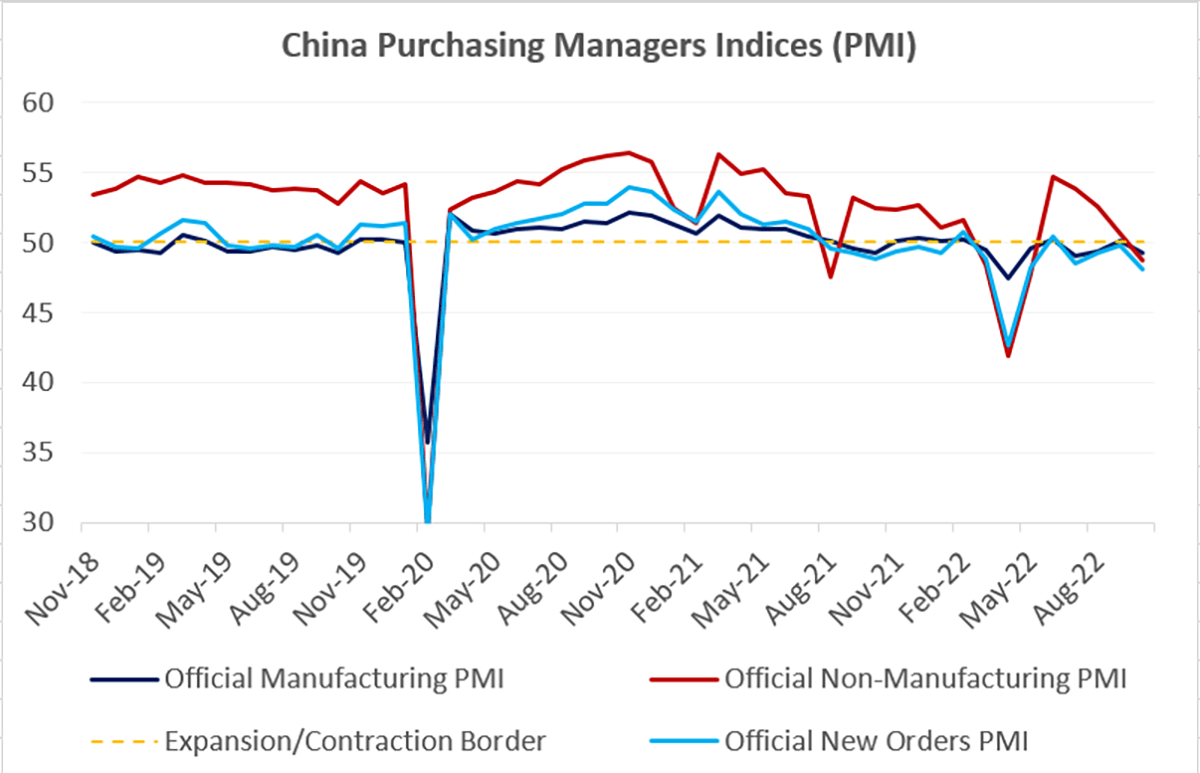CGinspiration/E+ via Getty Images
China’s activity surveys point to a weak start to Q4. Can further easing change the growth trajectory if the zero-COVID policy remains in place?
China Growth Outlook
China’s upside growth surprises do not seem to last. A better-than-expected Q3 GDP print was swiftly followed by the disappointing October activity gauges, most of which ended up in the contraction zone (see chart below).
This particular downside surprise was probably not completely unexpected, given that we are dealing with the same set of underlying reasons, including the zero-COVID policy (note that the survey was taken before the latest round of lockdowns) and the housing sector disruptions.
The question is what authorities are going to do about it, given (A) that China had already used a lot of policy space (especially on the fiscal side) and (B) that we saw a re-arrangement of priorities during the 20th congress of the communist party (CPC), with security and social stability now ranking higher than the continuity of economic policy (albeit one can argue that growth and social stability are closely related, especially if the labor market pressures persist).
China Policy Space
China is bucking the global policy-tightening trend – an exception among systemically important economies. China is expected to post the largest primary fiscal deficit among major emerging markets (EM) and developed markets (DM) both in 2022 and 2023 (as a % of GDP, according to the IMF projections).
The central bank made some small interest rate cuts and pledged – on several occasions – to step up credit support for “struggling” sectors. The latest “crop” of weaker-than-expected activity signals generated more calls from observers for “comprehensive policy easing” (or something along these lines).
The central bank can do more, for sure. However, the impact of additional easing on the real economy is likely to be muted as long as the zero-COVID policy stays in place.
China Growth Targets
So, are Chinese authorities OK with a slower growth path? The next set of official gatherings – including the Central Economic Work Conference in December – should shed more light on the 2023 official growth target.
The IMF sees China expanding by 4.4% next year – well below the customary 5-5.5% threshold – and the CPC’s reference to a more challenging global environment and rising geopolitical risks suggest that weaker growth might be tolerated for longer.
China’s upcoming credit and monetary aggregates (out next week) will be closely watched for signals of whether this is indeed the case. Stay tuned!
Chart at a Glance: China Activity Gauges – Stuck in Contraction Zone1

Source: Bloomberg LP
1We believe PMIs are a better indicator of the health of the Chinese economy than the gross domestic product (GDP) number, which is politicized and is a composite in any case. The manufacturing and non-manufacturing, or service, PMIs have been separated in order to understand the different sectors of the economy. These days, we believe the manufacturing PMI is the number to watch for cyclicality.
|
PMI – Purchasing Managers’ Index: economic indicators derived from monthly surveys of private sector companies. A reading above 50 indicates expansion, and a reading below 50 indicates contraction; ISM – Institute for Supply Management PMI: ISM releases an index based on more than 400 purchasing and supply managers surveys; both in the manufacturing and non-manufacturing industries; CPI – Consumer Price Index: an index of the variation in prices paid by typical consumers for retail goods and other items; PPI – Producer Price Index: a family of indexes that measures the average change in selling prices received by domestic producers of goods and services over time; PCE inflation– Personal Consumption Expenditures Price Index: one measure of U.S. inflation, tracking the change in prices of goods and services purchased by consumers throughout the economy; MSCI – Morgan Stanley Capital International: an American provider of equity, fixed income, hedge fund stock market indexes, and equity portfolio analysis tools; VIX – CBOE Volatility Index: an index created by the Chicago Board Options Exchange ((CBOE)), which shows the market’s expectation of 30-day volatility. It is constructed using the implied volatilities on S&P 500 index options.; GBI-EM – JP Morgan’s Government Bond Index – Emerging Markets: comprehensive emerging market debt benchmarks that track local currency bonds issued by Emerging market governments; EMBI– JP Morgan’s Emerging Market Bond Index: JP Morgan’s index of dollar-denominated sovereign bonds issued by a selection of emerging market countries; EMBIG – JP Morgan’s Emerging Market Bond Index Global: tracks total returns for traded external debt instruments in emerging markets. The information presented does not involve the rendering of personalized investment, financial, legal, or tax advice. This is not an offer to buy or sell, or a solicitation of any offer to buy or sell any of the securities mentioned herein. Certain statements contained herein may constitute projections, forecasts and other forward looking statements, which do not reflect actual results. Certain information may be provided by third-party sources and, although believed to be reliable, it has not been independently verified and its accuracy or completeness cannot be guaranteed. Any opinions, projections, forecasts, and forward-looking statements presented herein are valid as the date of this communication and are subject to change. The information herein represents the opinion of the author(s), but not necessarily those of VanEck. Investing in international markets carries risks such as currency fluctuation, regulatory risks, economic and political instability. Emerging markets involve heightened risks related to the same factors as well as increased volatility, lower trading volume, and less liquidity. Emerging markets can have greater custodial and operational risks, and less developed legal and accounting systems than developed markets. All investing is subject to risk, including the possible loss of the money you invest. As with any investment strategy, there is no guarantee that investment objectives will be met and investors may lose money. Diversification does not ensure a profit or protect against a loss in a declining market. Past performance is no guarantee of future performance. |
Editor’s Note: The summary bullets for this article were chosen by Seeking Alpha editors.


Be the first to comment